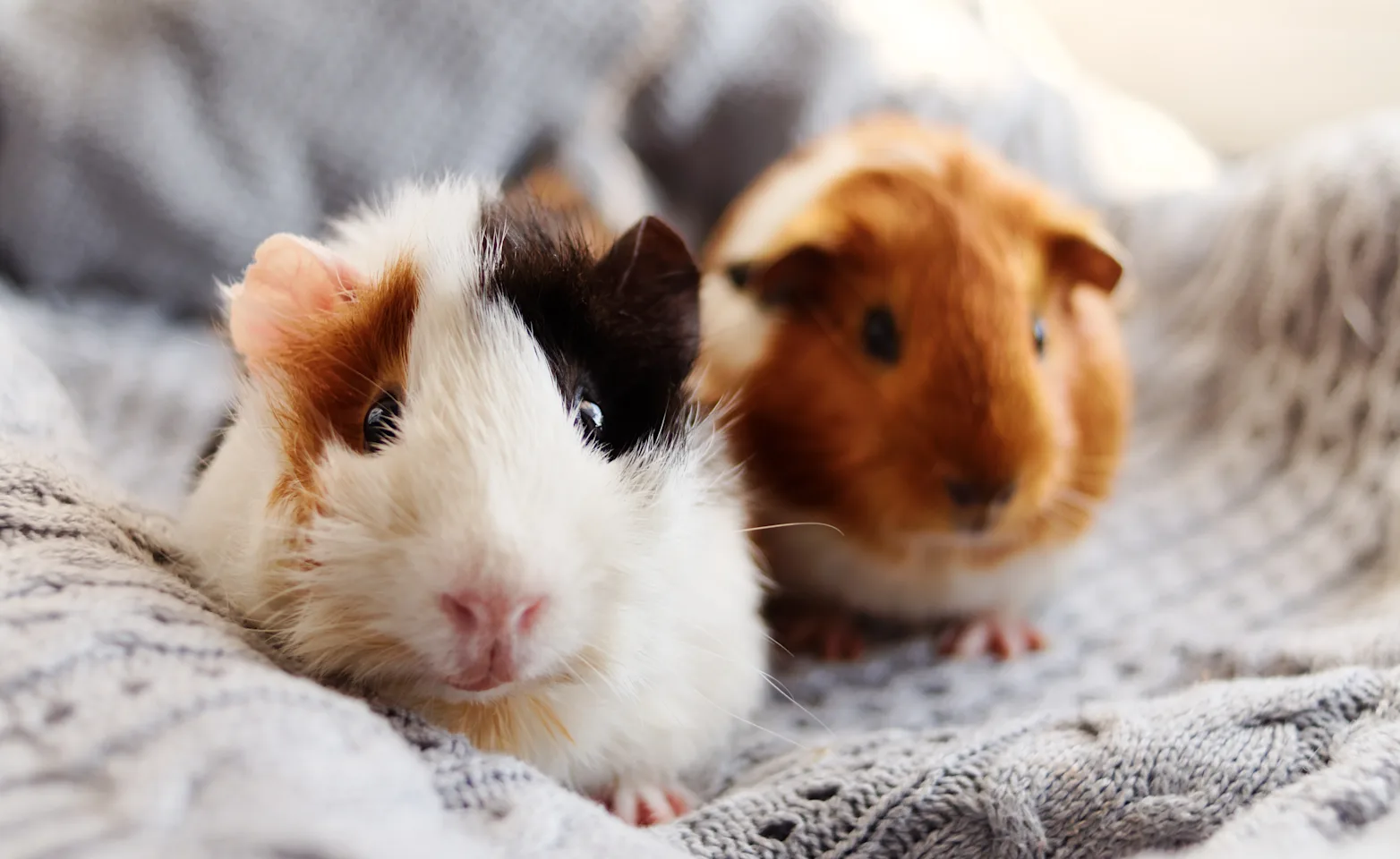Warren Woods Veterinary Hospital

Guinea pigs are rodents that are native to South America, where they were originally domesticated by the Incan people. In Europe and occasionally in North America a guinea pig may be referred to as a cavy (kay-vee). The American Cavy Breeders Association recognizes thirteen different breeds of domestic guinea pigs which come in a wide variety of coat textures and color patterns. When properly cared for, guinea pigs can be very interactive and friendly pets and may live for an average of four to seven years.
Guinea pigs prefer to live in pairs or small groups. A guinea pig that is housed alone requires a large amount of attention in order to prevent stress from boredom and loneliness. Newly introduced adult guinea pigs may fight with each other so it is best to introduce them while they are young, or to pair a young guinea pig with an adult. It is recommended to keep guinea pigs with others of the same sex to prevent unwanted breeding and possible associated complications. Guinea pigs are active and prefer a large amount of ground space in which to run and play.
Most guinea pigs are not good climbers, so a cage with twelve inch tall walls is usually sufficient to prevent escape. A well-ventilated cage top should be used if there are dogs or cats in the household. An ideal housing enclosure for a guinea pig has a solid base of at least four square feet per pig, is easy to clean, and has well ventilated siding. Non-toxic wire bars should form the sides of the cage, but avoid using cages with wire flooring. Guinea pigs have sensitive respiratory tracts and are prone to upper respiratory infections and pneumonia if they do not have adequate ventilation in their environment. Cages should also be kept at room temperature, 65 to 80 degrees Fahrenheit. They should be kept away from drafts, direct sunlight, and air contaminants such as smoke and aerosol air fresheners. Guinea pigs are sensitive to heat and should not be placed in direct sunlight or housed outside during the summer.
Recommended bedding for a guinea pig enclosure includes recycled paper products, shredded paper and corncob. Pine or cedar shavings are not recommended as the dust and aromatic oils in the shavings can cause respiratory, eye, and paw irritation. Guinea pigs are not easily litter box trained so their bedding should be changed frequently, ideally every three to five days.
Guinea pigs are grazing herbivores. They eat grass, hay and other forage and should have food available at all times. An ideal guinea pig diet includes free choice hay with a small amount of pellets (two to three teaspoons per pig per day) and a large amount of greens. Alfalfa hay and alfalfa based pellets are ideal for growing pigs younger than eight months and pregnant or lactating pigs. It should only be given in limited quantities to adult pigs after eight months of age because the high calcium levels in alfalfa may contribute to urinary stone formation. Ideal pellets for normal adult guinea pigs are those formulated from timothy hay. There are a variety of grass hays available to feed adult guinea pigs including timothy, orchard grass, and Bermuda grass hays. Make sure all hay and pellets are kept clean and dry and are free of mold. Fresh food should be removed from the cage if not eaten within a few hours to prevent rotting. Avoid sudden or drastic changes to the diet as this may lead to diarrhea.
Like humans, guinea pigs require a source of daily vitamin C in their diet. Commercial guinea pig diets contain some vitamin C, but it is recommended that the diet be supplemented daily with fresh vegetables especially dark, leafy greens. Each guinea pig should receive at least one quarter cup of fresh vegetables daily. Vegetables high in vitamin C that can be fed to a guinea pig include bell peppers, romaine lettuce, red lettuce, mustard greens and zucchini. Fruits are high in sugar and should only be given in small amounts as treats. Celery, carrots, collard greens and kale are healthy treats but should only be offered no more than once to twice a week. Cruciferous veggies such as broccoli, cauliflower, spinach, Brussels sprouts, and cabbage can cause gas and bloating, so these should only be offered no more than once a week. Guinea pigs should never be offered dairy products of any kind, mushrooms, seeds and nuts, onions, potatoes, raw beans and lentils. If a vitamin supplement is added to the water, a second source of plain, fresh water should also be available because some guinea pigs will not drink supplemented water due to the bitter taste. Liquid vitamin supplements are typically not recommended and are unnecessary if a guinea pig gets adequate daily greens. Hay-based vitamin C treats (ie Oxbow Natural Science treats) are tastier alternatives to liquid vitamins if a vitamin C supplement is desired.
There are a number of ailments that may affect guinea pigs. Urinary tract infections and urinary stones can be a problem in some guinea pigs so any change in frequency of urination or bloody urine requires a visit to the veterinarian. Guinea pigs may also be affected by upper respiratory infections which are accompanied by wheezing, sneezing, and crusty, watery eyes and nostrils. Hair loss, lumps, bumps or scabs may be signs of skin and coat ailments. A guinea pig exhibiting any of these signs should be examined by a veterinarian. Dental problems are fairly common in guinea pigs because their teeth grow continuously. Their teeth should be examined periodically by a veterinarian and overgrown teeth may need to be trimmed. If the guinea pig is kept for breeding purposes, the female should be bred for the first time before six months of age, or they can suffer from dystocia (difficulty giving birth). A guinea pig who is not eating, is reluctant to eat or drink, or has diarrhea should be taken to a veterinarian immediately. A guinea pig should see a vet at least once a year for a wellness exam or more often if they suffer from any of the previously mentioned ailments.
Additional Resources:
http://www.guinealynx.info/oxalic_acid_chart.html - (List of vegetables high in oxalic acid which can contribute to the formation of urinary stones).
